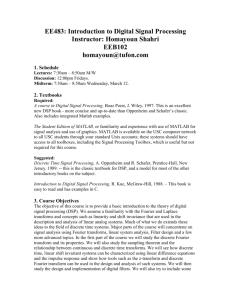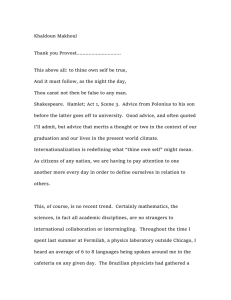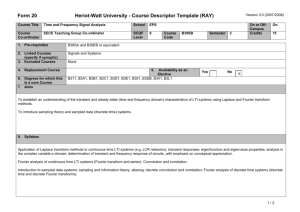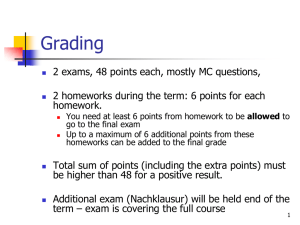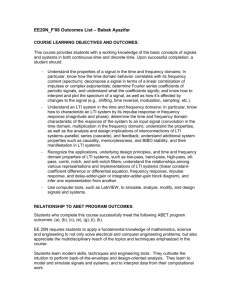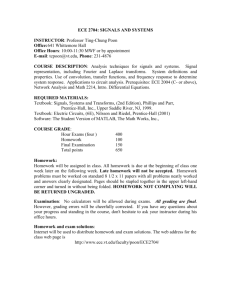EE483: Introduction to Digital Signal Processing Instructor: Richard M. Leahy
advertisement
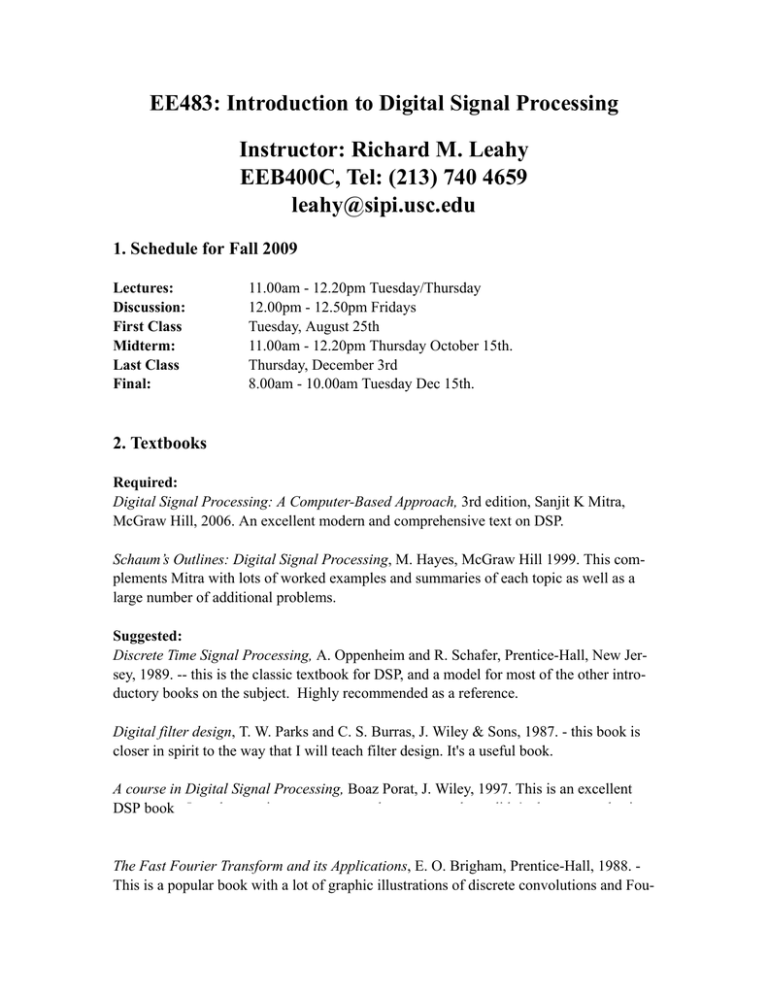
EE483: Introduction to Digital Signal Processing Instructor: Richard M. Leahy EEB400C, Tel: (213) 740 4659 leahy@sipi.usc.edu 1. Schedule for Fall 2009 Lectures: Discussion: First Class Midterm: Last Class Final: 11.00am - 12.20pm Tuesday/Thursday 12.00pm - 12.50pm Fridays Tuesday, August 25th 11.00am - 12.20pm Thursday October 15th. Thursday, December 3rd 8.00am - 10.00am Tuesday Dec 15th. 2. Textbooks Required: Digital Signal Processing: A Computer-Based Approach, 3rd edition, Sanjit K Mitra, McGraw Hill, 2006. An excellent modern and comprehensive text on DSP. Schaum’s Outlines: Digital Signal Processing, M. Hayes, McGraw Hill 1999. This complements Mitra with lots of worked examples and summaries of each topic as well as a large number of additional problems. Suggested: Discrete Time Signal Processing, A. Oppenheim and R. Schafer, Prentice-Hall, New Jersey, 1989. -- this is the classic textbook for DSP, and a model for most of the other introductory books on the subject. Highly recommended as a reference. Digital filter design, T. W. Parks and C. S. Burras, J. Wiley & Sons, 1987. - this book is closer in spirit to the way that I will teach filter design. It's a useful book. A course in Digital Signal Processing, Boaz Porat, J. Wiley, 1997. This is an excellent DSP book - I used to use it as a course text, but many students didn’t share my enthusiasm... The Fast Fourier Transform and its Applications, E. O. Brigham, Prentice-Hall, 1988. This is a popular book with a lot of graphic illustrations of discrete convolutions and Fou- rier transforms. I think it is very useful for developing a better understanding of the DFT but it is probably a little too basic to be of long term value. Digital Signal Processing, R. Roberts and Cliff Mullis, Addison Wesley, 1987 - this is a very good book on DSP - I used it as a course text a couple of times but it wasn't too popular with the students - it tends to be a little terse but covers a lot of ground. Introduction to Signal Processing, S. Orfandis, Prentice Hall, 1995 - a good book to read, lots of interesting examples. Others: there are a huge number of books on DSP, many of which are strongly influenced by O&S and in most cases are inferior. But do take a look in the bookstore or library at what else is available. 3. Course Objectives The objective of this course is to provide a basic introduction to the theory of digital signal processing (DSP). I assume a familiarity with complex variables, the Fourier and Laplace transforms and concepts such as linearity and shift invariance that are used in the description and analysis of linear analog systems. Much of what we do extends these ideas to the field of discrete-time systems. Major parts of the course will concentrate on signal analysis using Fourier transforms, linear system analysis, Filter design and a few more advanced topics. We will study the discrete Fourier transform and its properties. We will also study the sampling theorem and the relationship between continuous and discrete time transforms. We will see how discrete time, linear shift invariant systems can be characterized using linear difference equations and the impulse response and show how tools such as the z-transform and discrete Fourier transform can be used in the design and analysis of such systems. We will then study the design and implementation of digital filters. I will also include some topical material: how do 1-bit A/D converters work?, why is the DCT used in JPEG image compression?, what are adaptive filters? While this course deals largely with the theory of DSP, we will use a powerful software package, MATLAB, to look at applications of this theory, particularly Fourier analysis and digital filter design. 4. Course Evaluation Homework: 8-10 homeworks over the semester (20% of final grade) Midterm: 11.00am - 12.20pm ThursdayOctober 16th. (35% of final grade) Final Examination: 8.00am - 10.00am Tuesday Dec 16th. (45% of final grade) All exams are cumulative and closed book - please check the scheduled exam times now to see if there are any schedule conflicts. Homeworks must all be turned in by 5.00pm on the due date; this applies to both on-campus and DEN students. On campus students should place homeworks in the EE483 dropbox in EEB102. DEN students should submit homeworks electronically (http:// den.usc.edu/students/homework.htm). Late homeworks will not be graded. The final homework grade will be based on your average score after I discard the lowest score make sure that you do not miss more than one homework. Several of the homeworks will involve the use of Matlab - it is your responsibility to make sure that you have access to this package (it is available on USC computers) and that you learn how to use it. 5. On-Line Material All course materials will be distributed via the DEN website (http://den.usc.edu/). Access to the materials at the DEN website requires login with an individual i.d. and password. If you have problems accessing DEN please contact them the folks at DEN directly - see http://den.usc.edu/contact/index.htm for contact info and telephone numbers. All students enrolled in the class have access to all DEN materials, including the streamed lectures. I will post homeworks and solutions on the website. It is your responsibility to check the website regularly to check for new assignments and due dates. You will also have access to the lectures via streamed video. Please note - (live) attendance at the class is REQUIRED, either on campus or at a remote DEN location. The archived classes should be used only to review the material or if you miss a class because of illness or workrelated travel. 6. Office Hours, Discussion You can find me in EEB400C, Tel: (213) 740 4659. My office hours are 12.30-2.00pm Tuesdays and Thursdays. This is your opportunity to ask me about material covered in the class and technical aspects of homework assignments. Use it. If you have a time conflict with other classes during my office hours, let me know and I will make other arrangements to meet with you. Your TA for the course is Syed Ashrafulla (ashraful@usc.edu). He will do the discussions and hold office hours (times to be announced shortly). 7. Suggestions and Policies My primary interest here is that you learn as much as possible about digital signal processing, that you find the material interesting and that you finish the course wanting to know more about this subject. There are a few things that you can do to facilitate this: (i) ask me questions, (ii) make use of my office hours, (iii) when I ask you a question in class, don't pretend that you're not in the room, (iv) don't sit as far back as possible in the room, (iv) take an occasional trip to the library or bookstore or google to read something other than the required text book, (v) if you are struggling with the material, come and ask me about it as soon as you realize this and not the day before the midterm or final, (vi) learn to use MATLAB, (vii) turn in all of the homework assignments, (viii) remember that exams and grades are a means to an end and not the end in itself. It goes without saying that cheating on exams is unacceptable and will result in a minimum of the grade of F. Do the homework on your own although I would encourage you to discuss the problems with your friends. Likewise with the Matlab assignments: by all means discuss them, but you must write the code yourself. In cases where solutions are taken from a manual, from my prepared solutions, or are clearly the same as another students (either the text of your solution, or the Matlab code), you will receive an F for the course. Finally, please be on time - late arrivals are very disturbing to other students in the class and to me. 8. Outline Part 1: Signal and Systems in the Time Domain Class 1: Introduction and overview Class 2: continuous time signals and systems vs. discrete time signals and systems. Class 3: LTI systems, causality and BIBO stability, impulse response Class 4: Linear difference equations (LDEs) for LSI systems Part 2: Signal and Systems in the Fourier Domain Class 5: The Discrete Time Fourier Transform (DTFT) and its properties; practical aspects of convergence. Class 6: LTI systems: LDEs, the impulse response and the frequency response. Class 7: The importance of phase in signals and systems. Class 8: The discrete Fourier transform (DFT): definition and properties Class 9: Other unitary transforms and their applications. 2D transforms. Fast transforms. Class 10: Sampling of analog signals: aliasing, sampling theorem and signal reconstruction. Class 11: More sampling: 2D sampling, Fourier sampling, and applications Class 12: Sample rate modification and the sigma-delta converter. Compressed sensing Class 13: The four Fourier transforms. Relationships between the FT, DFT and DTFT: leakage, resolution Class 14: Practical spectral analysis Part 3: Z-transforms, LTI System Analysis and Digital Filters Class 15: The Z-transform, its invervee and its properties (Class 16: MIDTERM EXAM) Class 17: LTI systems and the system function. FIR and IIR systems. Poles and zeros. Class 18: Characterization of LTI systems summary - impulse response, LDEs, frequency response and system functions. Class 19: Filter types and applications I: Linear phase, minimum phase, and all-pass systems Class 20: Filter types and applications II: differentiators, Hilbert transformers Class 21: Overview of digital filter design Class 22: Design of Linear phase FIR filters - least squares and window design methods Class 23: Design of Linear phase FIR filters - Chebyschev approximation Class 24: IIR filter design from analog prototypes: bilinear transforms Class 25: IIR filter design by numerical optimization Class 26: Structures for digital filters Class 27: Quantization effects in digital systems Class 28: Introduction to adaptive filtering Class 29: Review

